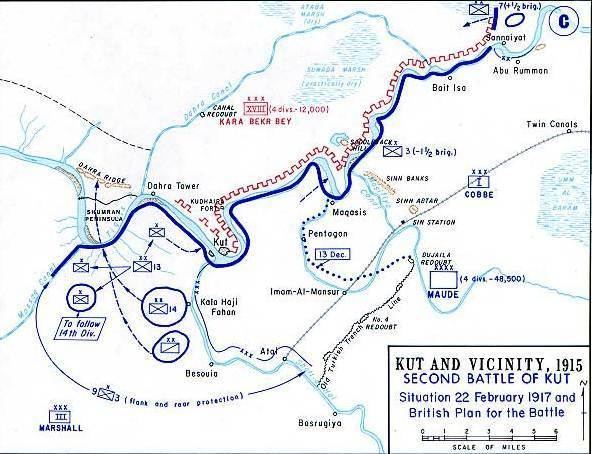The 14th Indian Division was formed during World War I, for service in the Mesopotamia Campaign. It was composed of Battalions of the Regular British Army, the British Territorial Force and the British Indian Army.
The Division now part of the Tigris Corps was involved in a number on minor engagements the Second Battle of Kut and the Fall of Baghdad, the Division's 36th Brigade was left in Baghdad as the Garrison.
The Division remained in Mesopotamia until the Armistice of Mudros 31 October 1918.
The division commanded the following units, although not all of them served at the same time:
1/5th Battalion, Buffs (East Kent Regiment)37th Dogras102nd King Edward's Own Grenadiers2nd Battalion, 4th Gurkha RiflesDeparted for the North Persia Force in June 1918, replaced by 56th Indian Brigade
1/4th Battalion, Hampshire Regiment26th Punjabis62nd Punjabis82nd Punjabis1st Battalion, 2nd King Edward's Own Gurkha Rifles (The Sirmoor Rifles)36th Sikhs64th Pioneers1/4th Battalion, Devonshire Regiment45th Rattray's Sikhs2nd Battalion, Norfolk Regiment2nd Battalion, 9th Gurkha Rifles1st Battalion, 67th Punjabis82nd Punjabis185th Machine Gun Company37th Light Trench Mortar BatteryJoined in August 1918 to replace 36th Indian Brigade
1/4th Battalion, Prince Albert's (Somerset Light Infantry)1st Battalion, 42nd Deoli Regiment95th Russell's Infantry104th Wellesley's Rifles1st Patiala Lancers (attached March to June 1918)2nd Indian Machine Gun Company56th Light Trench Mortar Battery13th Brigade Royal Field ArtilleryC/69th Howitzer battery Advance to the Hai and capture of the Khudaira Bend. 14 December 1916.Capture of the Hai Salient. 25 January – 5 February 1917.Capture of Sannaiyat. 17–24 February 1917.Second Battle of Kut. 23 February 1917Passage of the Tigris. 23–24 February 1917.Fall of Baghdad (1917). 8–11 March 1917Passage of the ‘Adhaim. 18 April 1917.Action of the Shatt al Adhaim. 30 April 1917.Second action of Jabal Hamrin. 16–20 October 1917.Third action of Jabal Hamrin. 3–6 December 1917.
